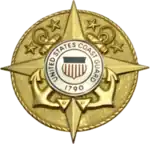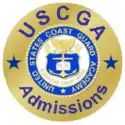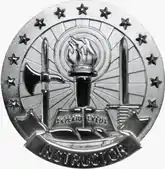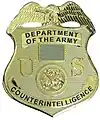Identification badges of the uniformed services of the United States
Identification badges of the uniformed services of the United States are insignia worn by service members conducting special duties, many of which can be awarded as permanent decorations if those duties are performed successfully. There are a few identification badges that are awarded to all services (such as the Presidential Service Badge), others are specific to a uniform service (such as the U.S. Army's Drill Sergeant Identification Badge). The Office of the President and Vice President and department/service headquarters badges are permanent decorations for those who successfully serve in those assignments. Some of the service level identification badges can be permanent decorations and others are only worn by a service member while performing specific duties, such as the Military Police Badge.[2][3][4][5][6][7][8][9]
.jpg.webp)
Command insignia/badges are another form of identification badge used to identify an officer or non-commissioned officer who is/was in command or in-charge of a unit. If the service member performs their leadership duties successfully, the command insignia/badge they wear can become a permanent uniform decoration regardless of their next assignment.[3][4][6][9]
The following is a list of identification badges currently in use by the uniformed services:
Executive branch
Department of Defense

.svg.png.webp)
 National Guard Bureau Organizational Badge
National Guard Bureau Organizational Badge
U.S. Army
U.S. Marine Corps
 Military Police Badge
Military Police Badge Military Police Corrections Badge
Military Police Corrections Badge Criminal Investigation Division Agent Badge
Criminal Investigation Division Agent Badge Marine Corps Counterintelligence Agent Badge
Marine Corps Counterintelligence Agent Badge
U.S. Navy






 Law Enforcement Badges
Law Enforcement Badges
U.S. Air Force
U.S. Space Force
 Commander's Insignia
Commander's Insignia Space Staff Badge
Space Staff Badge
 Lapel Insignia
Lapel Insignia
Department of Homeland Security
U.S. Coast Guard








 Officer-in-Charge Afloat Pin
Officer-in-Charge Afloat Pin Officer-in-Charge Ashore Pin
Officer-in-Charge Ashore Pin
 Commandant-designated Command Senior Enlisted Leader Identification Badges
Commandant-designated Command Senior Enlisted Leader Identification Badges Non-designated Command Senior Enlisted Leader Identification Badges
Non-designated Command Senior Enlisted Leader Identification Badges

 U.S. Coast Guard Auxiliary Past Officer Badge
U.S. Coast Guard Auxiliary Past Officer Badge
Department of Health and Human Services
U.S. Public Health Service Commissioned Corps
 Assistant Secretary for Health / Principal Deputy Secretary for Health Officer-in-Charge Badge
Assistant Secretary for Health / Principal Deputy Secretary for Health Officer-in-Charge Badge Surgeon General Badge
Surgeon General Badge Deputy Surgeon General Badge
Deputy Surgeon General Badge Officer-in-Charge Badge
Officer-in-Charge Badge Chief Professional Officer Badge
Chief Professional Officer Badge
 Music Ensemble Badge[11]
Music Ensemble Badge[11]
Department of Commerce
U.S. National Oceanic and Atmospheric Administration Commissioned Corps


 Chief-of-Party insignia
Chief-of-Party insignia
See also
- Military badges of the United States
- Awards and decorations of the Public Health Service
- Awards and decorations of the National Oceanic and Atmospheric Administration
- Obsolete badges of the United States military
- United States Army branch insignia
- List of United States Army careers
- List of United States Marine Corps MOS
- United States Navy staff corps
- List of United States Navy ratings
- Air Force Specialty Code
- List of United States Coast Guard ratings
References
- The Military Horseman Identification Badge (Image 4 of 5), DVIDS, by SPC Gabriel Silva, dated 29 September 2017, last accessed 2 October 2017
- U.S. Army Pamphlet 670–1: Uniform and Insignia, Guide to the Wear and Appearance of Army Uniforms and Insignia Archived 2014-05-06 at the Wayback Machine, Department of the Army, dated 31 March 2014, last accessed 23 June 2014
- U.S. Navy Uniform Regulations, Chapter 5 Archived 2011-04-18 at the Wayback Machine, updated 24 March 2011, last accessed 3 August 2013
- U.S. Air Force Instruction 36-2903: Dress and Personal Appearance of Air Force Personnel Archived 2018-11-02 at the Wayback Machine, dated 1 March 2013, last accessed 11 January 2014
- U.S. Marine Corps Order P1020.34G: Marine Corps Uniform Regulations, Chapters 1-5, Permanent Marine Corps Uniform Board, dated 30 March 2003, last updated 16 May 2008, last accessed 15 February 2015
- U.S. Coast Guard Uniform Regulation, M1020.6H, updated April 2013, last accessed 29 September 2013
- U.S. Coast Guard Auxiliary Manual, COMDTINST M16790.1G, dated 17 August 2011, last accessed 8 August 2016
- U.S. Public Health Service Commissioned Corps PPM 08-019, Wear of Skill and Breast Badges Archived 2012-04-26 at the Wayback Machine, dated 28 Aug 08, last accessed 10 December 11
- U.S. National Oceanic and Atmospheric Administration Commissioned Corps Directive, Chapter 12, Part 6, Insignia, Medals, and Ribbon Bars, dated 21 November 2003, last accessed 31 March 2013
- https://www.spaceforce.mil/News/Article/3017350/head-of-air-force-academys-astro-department-transfers-to-space-force/
- Public Health Service Music Ensemble Badge, United States Army Institute of Heraldry, last accessed 23 August 2020































